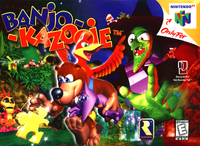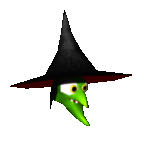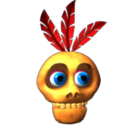June 19, 2018
By Ryan Porzl

Who would've thought an adventure game starring a honey bear with his red bird friend in his backpack as they venture to many worlds to stop an evil witch while collecting music notes and jigsaw puzzle pieces would become one of the greatest video games of all time? To Rare's credit, they did when they launched Banjo-Kazooie on June 29, 1998 on the Nintendo 64. To celebrate the upcoming 20th anniversary to one of video game's great masterpieces, we'll take a look at the original game as well as the history leading up to it, and the aftermath as the game's success would spawn a series.
Characters
 Gruntilda- An ugly, evil witch who speaks in rhyme and the main antagonist of the game. Gruntilda kidnaps Banjo's sister Tooty due to her jealousy of Tooty's beauty and plans to transfer Tooty's beauty to her via a machine which results in the events of the game as Banjo & Kazooie journey to her castle to rescue Tooty and stop Gruntilda.
Gruntilda- An ugly, evil witch who speaks in rhyme and the main antagonist of the game. Gruntilda kidnaps Banjo's sister Tooty due to her jealousy of Tooty's beauty and plans to transfer Tooty's beauty to her via a machine which results in the events of the game as Banjo & Kazooie journey to her castle to rescue Tooty and stop Gruntilda. Mumbo Jumbo- A skull faced shaman who can transform Banjo & Kazooie into something be it animal or object in certain levels with the transformations being different for each level. The transformations allow Banjo & Kazooie to advance in a level and can help get past certain enemies thus allowing them to collect music notes and jiggies that they normally couldn't get. The transformations require a certain number of Mumbo tokens scattered throughout the levels. After giving enough tokens, Banjo & Kazooie can use that specific transformation as much as they want. However, it's restricted to the level and can't be used outside of it.
Mumbo Jumbo- A skull faced shaman who can transform Banjo & Kazooie into something be it animal or object in certain levels with the transformations being different for each level. The transformations allow Banjo & Kazooie to advance in a level and can help get past certain enemies thus allowing them to collect music notes and jiggies that they normally couldn't get. The transformations require a certain number of Mumbo tokens scattered throughout the levels. After giving enough tokens, Banjo & Kazooie can use that specific transformation as much as they want. However, it's restricted to the level and can't be used outside of it. Tooty- Banjo's younger sister who is kidnapped by Gruntilda due to the witch's jealousy of her beauty as well as hoping to transfer Tooty's beauty to her. Banjo & Kazooie then set out to rescue her before Gruntilda succeeds. If the player quits the game at anytime or gets a game over before rescuing Tooty, a cutscene will show Gruntilda succeeding in her scheme transforming into a beautiful woman while Tooty becomes grotesque. Tooty is eventually rescued when Banjo & Kazooie win Gruntilda's game show Grunty's Furnace Fun. Oddly enough, despite being a major character in the game, Tooty is absent in future games outside of cameos.
Tooty- Banjo's younger sister who is kidnapped by Gruntilda due to the witch's jealousy of her beauty as well as hoping to transfer Tooty's beauty to her. Banjo & Kazooie then set out to rescue her before Gruntilda succeeds. If the player quits the game at anytime or gets a game over before rescuing Tooty, a cutscene will show Gruntilda succeeding in her scheme transforming into a beautiful woman while Tooty becomes grotesque. Tooty is eventually rescued when Banjo & Kazooie win Gruntilda's game show Grunty's Furnace Fun. Oddly enough, despite being a major character in the game, Tooty is absent in future games outside of cameos.Gameplay
The game plays similar to fellow Nintendo 64 game Super Mario 64 in that it features a giant overworld to explore, mostly consisting of Spiral Mountain and Gruntilda's Lair with access to the levels scattered throughout. The levels include Mumbo's Mountain, Treasure Trove Cove, Clanker's Cavern, Bubblegloop Swamp, Freezeezy Peak, Gobi's Valley, Mad Monster Mansion, Rusty Bucket Bay, and Click Clock Woods. Each level contains 100 musical notes, 5 creatures called jinjos, and 10 jigsaw puzzle pieces called "jiggies". In the original N64 version, the player was required to collect all musical notes and jinjos without leaving a level or dying or they would lose all they collected in that level (this was taken out of the XBox Live Arcade version in 2008). Throughout Gruntilda's Lair portion of the overworld, 12 musical doors block Banjo & Kazooie from advancing. They can be opened once Banjo & Kazooie collect a certain number of musical notes in each level. Jinjos are colorful creatures with five in each level including a blue one, an orange one, a green one, a purple one, and a yellow one. After collecting all 5 in one level, you will be rewarded with one jiggy while the jinjos also play a part in the final battle against Gruntilda. The Jiggies are needed to enter new levels. Near every level's entrance, an incomplete portrait of the level is hung near it with the player needing jiggies the complete the portrait. Once the player fills enough jiggies to complete the portrait, the entrance will open and allow the player to play the level. Another item are empty honeycombs that are in hidden areas hard to reach. Once the player collects six, Banjo & Kazooie's health increases by one honeycomb as the health bar is made up of honeycombs. Finally, there is the spell book Cheato who can give the player 3 cheats to beat Gruntilda after finding him in three locations.
The game also featured an infamous and interesting addition called the "Stop n' Swop". Rare planned for "Stop n' Swop" to be a feature where players can collect six hidden colorful eggs and an ice key that would be used for the sequel game "Banjo-Tooie". The way it worked was after acquiring all the eggs and ice key, the player would have ten seconds to switch cartridges from Banjo-Kazooie to Banjo-Tooie after turning the system off. Unfortunately, because of revisions in the Nintendo 64 hardware, the player was only given one second to do it which was, obviously, impossible and it didn't work out. In 2008, Rare took advantage of the more advanced XBox 360 with the re-release of Banjo-Kazooie to the XBox Live Arcade by making the Stop n' Swop feature to be used for the then upcoming "Banjo-Kazooie: Nuts & Bolts" with the eggs hatching vehicle parts that can be used. When Banjo-Tooie was re-released, the Stop n' Swop was included and fixed without having seconds to switch game, making it possible and easier to use it. It was later revealed that the ice key unlocks an ice vault containing a creature called "Mega-Glowbo" which can transform Kazooie into a dragon. The Blue Mystery egg unlocks homing eggs to be used as weapons in Tooie while unlocking a Goldfish part in Nuts & Bolts. The Yellow Mystery egg unlocks a jinjo to be used in multiplayer in Tooie. The Pink Mystery egg unlocks the move breegull bash in Tooie while unlocking the fuzzy dice vehicle part in Nuts & Bolts. The Cyan Mystery egg unlocks Stop n' Swop II which includes 7 new awards to get that only appears in the XBox Live Arcade version while unlocking Mole-on-a-Pole in Nuts & Bolts. The Red Mystery egg unlocks the Banjo-Kazooie theme for XBox 360.
Behind The Scenes
Banjo-Kazooie's origins go all the way back to the early to mid 1990s when Rare was planning on a game called "Project Dream" intended for the Super Nintendo Entertainment System that was to be worked on by the same team that made Rare's 1995 Super Nintendo game Donkey Kong Country 2: Diddy's Kong Quest and would use Rare's Advanced Computer Modeling graphics technology that was originally used for 1994's Donkey Kong Country. Originally, the game would star a boy named Edison who would wield a wooden sword and get into trouble with pirates. Eventually, plans for the game changed with Edison being scrapped in favor of a rabbit before settling on a bear who became Banjo. The project hit a snag and was largely cancelled by 1996 with the introduction of the Nintendo 64 which rendered ACM obsolete.
In March 1997, the game that became Banjo-Kazooie began production. Originally, Rare had ten people on the development before expanding it to fifteen which included seven engineers, five artists, two designers, and one musician. The experience level ran the gambit with some working at Rare for as long as ten years while others never worked on a video game before. Rare was inspired by both Super Mario 64's world & Donkey Kong Country's look for the Banjo-Kazooie world while Rare hoped to design a game that appealed to people of all ages like Walt Disney Animation. It was settled by Rare to have an action game that focused on Banjo and his abilities. Eventually, Kazooie was added while Banjo's abilities were being thought out. Kazooie was to allow Banjo to walk faster and have wings pop out of his backpack that could help do a second jump. The name Kazooie came from the instrument kazoo due to a kazoo being considered an annoying instrument just like Kazooie's personality. Gruntilda was inspired by a character named Grotbags who was the main character of a British children's show called Grotbags. Despite Nintendo 64 allowing dialogue, Rare decided to have the character talk in a mumbled way since they thought the characters actually talking "could ruin the player's perception of the characters".
The game took over seventeen months to complete after Project Dream was scrapped. Previews for the game were shown at the 1997 E3 convention and Rare projected a late 1997 release, likely to meet the profitable Christmas season but was ultimately delayed until the summer of 1998. Despite the delay, things would get interesting as Banjo would make his debut early when he became a playable racer in the Nintendo 64 game Diddy Kong Racing which was released on November 21, 1997, eight months before Banjo-Kazooie. The game was designed by long time Rare designer Gregg Mayles who previously worked as a designer on the Battletoads and Donkey Kong Country games while having been one of the creators of Diddy Kong. He later did additional design work for Donkey Kong 64 while designing Conker's Bad Fur Day & Star Fox Adventures along with the Banjo-Kazooie sequels. His brother Steve would serve as one of the artists while later working on the "spiritual successor" "Yooka-Laylee". Composer Grant Kirkhope did the soundtrack. Kirkhope previously worked on Rare games like Donkey Kong Land 2 and Goldeneye 007 while later working on some of the Banjo-Kazooie sequels as well as Perfect Dark, Donkey Kong 64, Star Fox Adventures, & Viva Pinata along with Yooka-Laylee.
Release
Banjo-Kazooie was finally released on June 29, 1998 in North America and July 17, 1998 in Europe to critical acclaim. GameRankings scored it 92.38%, Metacritic scored it 92/100, AllGame scored it 4.5 our of 5 stars, Edge scored it 8/10, GamePro gave it a perfect score of 5 stars, Game Revolution gave it an A-, GameSpot gave it a 9.5 out of 10, IGN gave it a 9.6 out of 10, N64 Magazine gave it 92%, and Nintendo Power gave it a 9.2 out of 10. The game proceeded to sell 1.8 million units in North America and 405,000 in Japan. The game also won many awards including the Academy of Interactive Arts & Sciences' Console Action Game of the Year & Outstanding Achievement in Arts/Graphics in 1999 as well as IGN's Best Overall Graphics, Best Texture Design, and Best Music Awards for 1998.
The game's graphics & level design was the most praised while many favorably the game compared it to Super Mario 64. Along with graphics, the game also got positive reviews for it's creativity, characters, and the puzzles but was criticized for it's camera angles especially when having to swim to get collectibles. Since it's release 20 years ago, many game sites, critics, and fans have considered it one of the greatest video games of all time.
Aftermath
Due to the huge critical and commercial success, Banjo-Kazooie became a series with a sequel called "Banjo-Tooie" released in 2000. In 2002, Rare was purchased by Microsoft which included the Banjo-Kazooie series. Despite this, two games were released on Nintendo's Gameboy Advance (due to Microsoft not competing with Nintendo in the portable system market) in 2003's Banjo-Kazooie: Grunty's Revenge which was a prequel game & 2005's Banjo-Pilot which was a racing game that replaced the cancelled Diddy Kong Pilot due to Microsoft purchasing Rare. However, Microsoft's purchase of Rare saw Banjo omitted from Diddy Kong Racing DS (a re-release of Diddy Kong Racing on the Nintendo DS) in 2007. 2008 would be a busy year as Banjo-Kazooie was re-released on December 3rd on the XBox Live Arcade and the series returned to consoles when Banjo-Kazooie: Nuts & Bolts was released that November (11th in NA, 14th in EU, and 20th in AU). Nuts & Bolts would be a departure from the classic N64 games as it was more vehicle based instead of a platform. After the re-release of Banjo-Tooie in 2009, the series sadly has gone dormant. Banjo and Kazooie did appear in the XBox 360 version of 2010's Sonic & Sega All-Stars Racing while some of the character's skins have appeared as downloadable content for the XBox 360 version of 2011's Minecraft. Over the years, there have been rumors of a return of Banjo-Kazooie including Nintendo buying the series and making new games with Retro Studios or the two appearing in a Super Smash Bros. game but nothing ever came of it. Going into Banjo-Kazooie's 20th Anniversary, a new game hasn't been made in 10 years and it's unknown when or if the next one will come out. Despite Banjo-Kazooie gathering dust, former employees of Rare would create a "spiritual successor" to Banjo-Kazooie called "Yooka-Laylee" which came out in 2017.
Despite the uncertain future of the series, one thing is certain and that the original Banjo-Kazooie is a treasure to video games and the fact it's still loved and played 20 years later proves it. It's a game that's aged well during an era when games that came out the same time didn't. With the 20th Anniversary approaching, it's nice to look back and celebrate one of the greatest video games of all time.
No comments:
Post a Comment